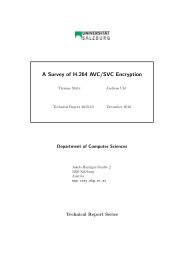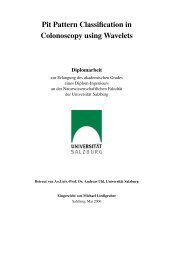Single-sensor hand and footprint-based multimodal biometric ...
Single-sensor hand and footprint-based multimodal biometric ...
Single-sensor hand and footprint-based multimodal biometric ...
Create successful ePaper yourself
Turn your PDF publications into a flip-book with our unique Google optimized e-Paper software.
2.1 Identification versus Verification<br />
Definition 2.1.4 (Verification system). Given a <strong>biometric</strong> sample X ∈ X <strong>and</strong> a<br />
claimed identity i ∈ {1, . . . , m}, a verification system is a function V : X × M →<br />
{genuine, imposter} determining whether the claim is true by returning the class<br />
genuine or whether the claim is false by returning imposter, <strong>based</strong> on a threshold η:<br />
V (X, mi) :=<br />
�<br />
genuine, if S(E(X), ii) ≥ η;<br />
imposter, otherwise.<br />
2. Identification: Only the acquired <strong>biometric</strong> sample is used for reliable determination<br />
of the identity of the access claiming person. Thus, screening against all stored<br />
reference templates (one-to-many comparison) is needed, see [14].<br />
Definition 2.1.5 (Identification system). Given a <strong>biometric</strong> sample X ∈ X , an<br />
identification system is a function I : X → M ∪ {reject} determining the identity<br />
mi, i ∈ {1, . . . , m} if existing or the state reject in case of no suitable identity can be<br />
determined:<br />
⎧<br />
⎨ mi, if i = arg max{S(E(X),<br />
ij)} ∧ S(E(X), ii) ≥ η;<br />
I(X) :=<br />
j<br />
⎩<br />
reject, otherwise.<br />
Apart from this definition of identification systems, the following variants exist [1]:<br />
sometimes the whole set of matching identities, i.e. the set {mi : S(E(X), ii) ≥ η},<br />
is considered (threshold-<strong>based</strong> identification). Another variant, not necessarily <strong>based</strong><br />
on scores, is rank-<strong>based</strong> identification where the matcher is expected to return a<br />
fixed size k-dimensional ranking vector (mπ(1), mπ(2), . . . , mπ(k)) with π a permutation<br />
of {1, . . . , m}. Finally, there are also hybrid approaches returning a variable-sized<br />
ranking vector of maximum length k containing only templates exceeding the defined<br />
threshold.<br />
It is clear, that running systems in identification mode is more challenging for the following<br />
reasons:<br />
• Security: System error rates largely depend on the number of enroled members.<br />
This circumstance is illustrated by the following experiment: assuming a system<br />
operates at 0.1% False Accept Rate (FAR, the rate of falsely accepted imposter<br />
authentication attempts) with a member database size of n = 250, a single imposter<br />
trying to cheat the system will be lucky in approximately 1 − 0.999 250 ≈ 22.13%<br />
of the cases (assuming a simplified model with equal FAR for each identity in the<br />
system database [1]). However, using a database size of n = 2500 the probability of<br />
being falsely accepted increases to 91.8%;<br />
• Performance: The number of necessary comparisons increases with the number<br />
of enroled members. Large databases, such as the FBI Integrated Automated Fingerprint<br />
Identification System [48] with fingerprints of over 47 million subjects as of<br />
July 2007, need fast matching algorithms in order to be able to respond in reasonable<br />
time.<br />
9








